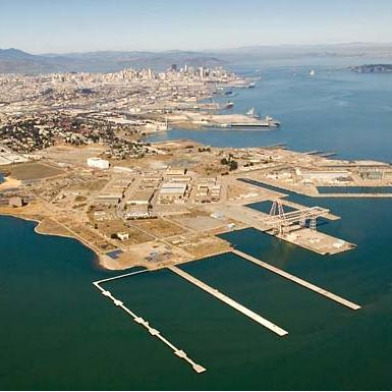 900-foot bridge valued at $100 million; “Is this it?”
900-foot bridge valued at $100 million; “Is this it?”
The city broke ground on the biggest redevelopment project in its history and welcomed the first of tens of thousands of tenants who will call Hunters Point Shipyard home on Tuesday — wait, we’re getting ahead of ourselves.
After years of debate, the Board of Supervisors gave first approval to a bevy of legislation that would allow Lennar Corporation — in theory, of course — to continue its transformation of San Francisco’s southeastern sector from a empty shipyard polluted with nuclear runoff and toxic waste to what has been billed as a landmark, once-in-a-lifetime, city-transforming construction project.
The Board of Supervisors’ chamber erupted in applause, hugs and handshakes as supervisors congratulated themselves and others for their historic vote. In a statement emailed to media shortly after the vote (but not online at publication time), Mayor Newsom echoed that applause, saying “Now we can truly begin the work of transforming an environmental blight into a new center of thousands of permanent and construction jobs, green technology investment, affordable housing and parks for our City.”
Is this it? Well… no, not really. Financing still must be secured, and Lennar must actually build the thing. Details, details.
Effort to kill bridge fails
If Lennar Corporation were not allowed to build a bridge over Yosemite Slough as part of its Hunters Point Shipyard redevelopment project, the entire project would be thrown into jeopardy, city officials warned Tuesday.
Michael Cohen, the head of the Mayor’s Office of Workforce and Economic Development and long the city’s frontman on the project, said that every long-term fiscal plan requires a bridge: from securing the loans needed to finance the project, to making the planned commercial space is viable for tenants, to ensuring the city can glean the roughly $100 million in tax revenue needed to pay for the public benefits the project promises (and which were key in wooing voter approval in the first place).
“It is so fundamental, for the land use underpinnings and the financial underpinnings” that removing it would create “an unacceptable level of uncertainty,” said Cohen, whose argument seemed to be the final death knell for an effort to kill the bridge.
Originally, the 902-foot-long bridge was to be 83 feet wide, big enough to accommodate football game day traffic (should the 49ers build a stadium at Hunters Point) as well as vehicles of daily commuters shuttling to or from housing or businesses in the new development.
A few weeks ago, Supervisor David Chiu proposed reducing the bridge in size by half, from 83 feet and four lanes to 41 feet and two lanes.
Supervisor Ross Mirkarimi had floated a plan that would have provided for a no-bridge alternative, but perhaps thanks to Cohen’s arguments, his effort was voted down by his Board colleagues, 6-5.
“The point is, there’s no economic analysis” to back up Cohen’s statements, Mirkarimi said.
Cutting the bridge in half was only one of a host of amendments to the shipyard redevelopment plan supervisors attempted to insert during Tuesday’s meeting. Supervisor Chris Daly also attempted to insert amendments guaranteeing that the soil around the polluted shipyard — which is host to two EPA Superfund sites — meet USDA organic food growing standards in order for housing to be built, and that “no fossil fuel-powered district heating or cooling systems” be included in plans for the project. That, too, was voted down.









